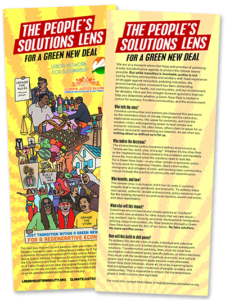From https://climatejusticealliance.org/
We are at a moment where the hope and promise of achieving a bold, transformative agenda to protect the climate seems possible. But while transition is inevitable, justice is not. Led by frontline communities and workers with lived experience of struggle against extractive, polluting industries, the environmental justice movement has been demanding protection of our health, our communities, and our environment for decades. Here are five straight-forward questions that can help you determine whether a Green New Deal is rooted in justice for workers, frontline communities, and the environment:
ONE. Who tells the story?
Frontline communities and workers are impacted first and worst by the interlinked crises of climate change and the extractive, exploitative economy. We speak for ourselves, and hold the wisdom, vision, and organizing power to lead climate and economic solutions. Yet, often times, others claim to speak for us without necessarily representing our interests. As we often say, nothing about us without us is for us.
TWO. Who makes the decisions?
The environmental justice movement defines environment as “where we live, work, play, and pray”. Whether it’s the shop floor or the neighborhood, those closest to the problems will inevitably know the most about what the solutions need to look like. For a Green New Deal – or any other climate or economic policy – to truly work for Indigenous Peoples, Black communities, immigrants and refugees of color, and working class communities, it must embody the practice of community self-determination.
THREE. Who benefits, and how?
The climate crisis is ecological, but it has its roots in systemic inequity that is racial, gendered, and economic. To address these root causes, authentic climate and economic policy solutions must flip the existing dynamics around racial injustice, wealth extraction, and labor exploitation.
FOUR. What else will this impact?
Sometimes environmental and climate policies or “solutions” can create new problems for other issues that we care about—e.g. workers’ rights, housing, economic development, immigration, policing, mass incarceration, etc. Real solutions through a Green New Deal must work for ALL of our issues. No false solutions. No more sacrifice zones.
FIVE. How will this build or shift power?
To address the climate crisis at scale, individual and collective solutions must put us in a better position to pursue subsequent solutions. Transformative solutions, then, must do more than accomplish individualized goals, specific policies, or select elections; they must shift the landscape of political, economic, and cultural power such that subsequent goals become more attainable. Green New Deal initiatives, above all, must be organizing tools that bring together a mass movement of people, workers, and communities. This is imperative to ensure the implementation phase is both inclusive and equitable.
This tool was inspired by and adapted, with permission, from the original People’s Solutions Lens—a collaborative creation by It Takes Roots (a frontline formation composed of Climate Justice Alliance, Grassroots Global Justice Alliance, Indigenous Environmental Network, and Right to the City Alliance) and their Funder Support Circle. For more information on It Takes Roots, and to view the original People’s Solutions Lens, which speaks to climate solutions, visit: http://ittakesroots.org/peoplesorientation/ or email: peoplessolutionslens@ittakesroots.org.

